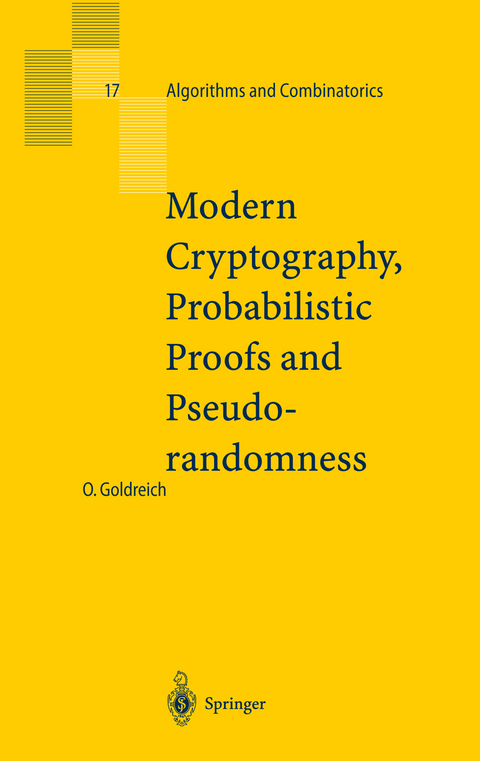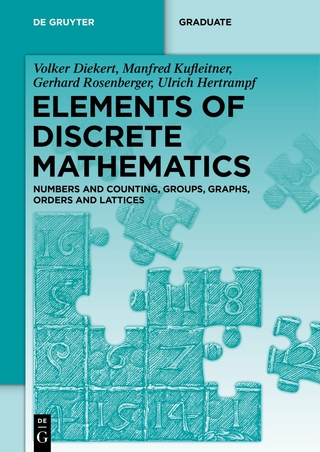
Modern Cryptography, Probabilistic Proofs and Pseudorandomness
Springer Berlin (Verlag)
978-3-540-64766-9 (ISBN)
1. The Foundations of Modern Cryptography.- 2. Probabilistic Proof Systems.- 3. Pseudorandom Generators.- A. Background on Randomness and Computation.- A.1 Probability Theory - Three Inequalities.- A.2 Computational Models and Complexity Classes.- A.2.1 P, NP, and More.- A.2.2 Probabilistic Polynomial-Time.- A.2.3 Non-Uniform Polynomial-Time.- A.2.4 Oracle Machines.- A.2.5 Space Bounded Machines.- A.2.6 Average-Case Complexity.- A.3 Complexity Classes - Glossary.- A.4 Some Basic Cryptographic Settings.- A.4.1 Encryption Schemes.- A.4.2 Digital Signatures and Message Authentication.- A.4.3 The RSA and Rabin Functions.- B. Randomized Computations.- B.1 Randomized Algorithms.- B.1.1 Approx. Counting of DNF Satisfying Assignments.- B.1.2 Finding a Perfect Matching.- B.1.3 Testing Whether Polynomials Are Identical.- B.1.4 Randomized Rounding Applied to MaxSAT.- B.1.5 Primality Testing.- B.1.6 Testing Graph Connectivity via a Random Walk.- B.1.7 Finding Minimum Cuts in Graphs.- B.2 Randomness in Complexity Theory.- B.2.1 Reducing (Approximate) Counting to Deciding.- B.2.2 Two-sided Error Versus One-sided Error.- B.2.3 The Permanent: Worst-Case vs Average Case.- B.3 Randomness in Distributed Computing.- B.3.1 Testing String Equality.- B.3.2 Routing in Networks.- B.3.3 Byzantine Agreement.- B.4 Bibliographic Notes.- C. Two Proofs.- C.1 Parallel Repetition of Interactive Proofs.- C.2 A Generic Hard-Core Predicate.- C.2.1 A Motivating Discussion.- C.2.2 Back to the Formal Argument.- D. Related Surveys by the Author.
From the reviews:
"This book is intended for a reader with some knowledge of the theory of computing. It is divided into three chapters, each a survey of one of the topics mentioned in the title. The chapters may be read independently, and are somewhat different in nature. ...The book ends with four appendices. The first summarises the probability theory, complexity theory and cryptography that is used in the body of the book. The second gives examples of randomisation in algorithmic problems, complexity theory and distributed computing. The third contains two proofs, not to be found in the literature, of well-known results. The last appendix lists other surveys by the author." (Simon R. Blackburn, Mathematical Reviews)
"Modern cryptography, probabilistic proofs and pseudorandomness are three areas in theoretical computer science that demonstrate the interplay between randomness and computations. ... This book is informative and rich in content. ... the most appealing feature of this book is that it leans toward the intuition and historical motivations around these topics. ... it is an excellent resource for students and researchers ... . this book will probably give you a good collection of background motivations and nice discussions as well." (Andrew C. Lee, SIGACT News, Vol. 34 (4), 2003)
| Erscheint lt. Verlag | 24.11.1998 |
|---|---|
| Reihe/Serie | Algorithms and Combinatorics |
| Zusatzinfo | XV, 183 p. 1 illus. |
| Verlagsort | Berlin |
| Sprache | englisch |
| Maße | 155 x 235 mm |
| Gewicht | 452 g |
| Themenwelt | Mathematik / Informatik ► Mathematik ► Graphentheorie |
| Mathematik / Informatik ► Mathematik ► Wahrscheinlichkeit / Kombinatorik | |
| Schlagworte | algorithms • Approximation • authentication • combinatorics • Complexity • Complexity theory • cryptography • digital signature • Encryption • Erfüllbarkeitsproblem der Aussagenlogik • Graphs • Komplexitätstheorie • Kryptographie / Kryptologie • Matching • Network • Probability Theory • Radnomness • Randomness and Computation • Random Walk • SIGNATUR • Wahrscheinlichkeitstheorie • Zufall / Random (Statistik) • Zufall (Statistik) |
| ISBN-10 | 3-540-64766-X / 354064766X |
| ISBN-13 | 978-3-540-64766-9 / 9783540647669 |
| Zustand | Neuware |
| Haben Sie eine Frage zum Produkt? |
aus dem Bereich

